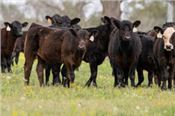Gradual Weaning Of Calves Reduces Stress, Increases Profits

Producers can reduce stress on calves by weaning them while they are still on the farm. Calves with less stress have fewer diseases and lower morbidity when they go to the feedlot.
Photo courtesy of Eric Bailey.
COLUMBIA, MO.
Weaning at home reduces stress and improves profit in calves, says University of Missouri Extension beef nutritionist Eric Bailey.
Unfortunately, more than 55 percent of calves are weaned on the trailer on the way to the sale barn, according to USDA National Animal Health Monitoring System surveys.
Calves face many types of stress in their early days, including weaning, castration, vaccinations, diet changes and transportation.
Stress increases their risk of contracting a respiratory disease upon entering the feedlot. Bailey says 17 percent of calves entering the feedlot show signs of respiratory disease. This costs the beef industry $800 million annually.
Producers can reduce some of that stress by weaning at home, which Bailey calls a “tried-and-true” method.
A couple of “at home” techniques:
• Nose clips in the nostril, which prevent the calf from sucking and encourage them to eat hay and feed concentrates. After the nose clip is removed, calves are physically separated from their dams. This low- stress method costs about $2.25 per nose flap.
• Fence line weaning puts calves on one side of the fence and mama cows on the other side for five to seven days after weaning. Good fences help in this method. Fence line weaning improves performance and helps calves bawl less. Calves that are abruptly removed from their mothers bawl twice as much as gradually weaned calves.
Calves that don’t eat well after weaning face risk for illness, generally 14-28 days after weaning. Producers can encourage drinking and eating by placing physical barriers within the pen so that calves must walk past water and feed sources.
Bailey also suggests a method to adapt weaned calves to new feed. On the day of weaning, offer calves 1 percent or more of their body weight in high quality grass hay. The next day, offer hay at 1 percent of body weight and begin to offer 0.5-1 percent of body weight in grain. Put the grain under hay in the bunk to get calves to eat down to the new feed. Putting a new feed on top may cause calves to avoid it, he says.
Increase the concentrate to 1 pound (dry matter basis) each day until cattle are eating 2.5 percent of their body weight in concentrate.
Discontinue hay between days three and five.
Find more information on this and other beef and forage topics on MU Extension’s Integrated Pest Management YouTube channel at youtube.com/user/MUIPM. ∆